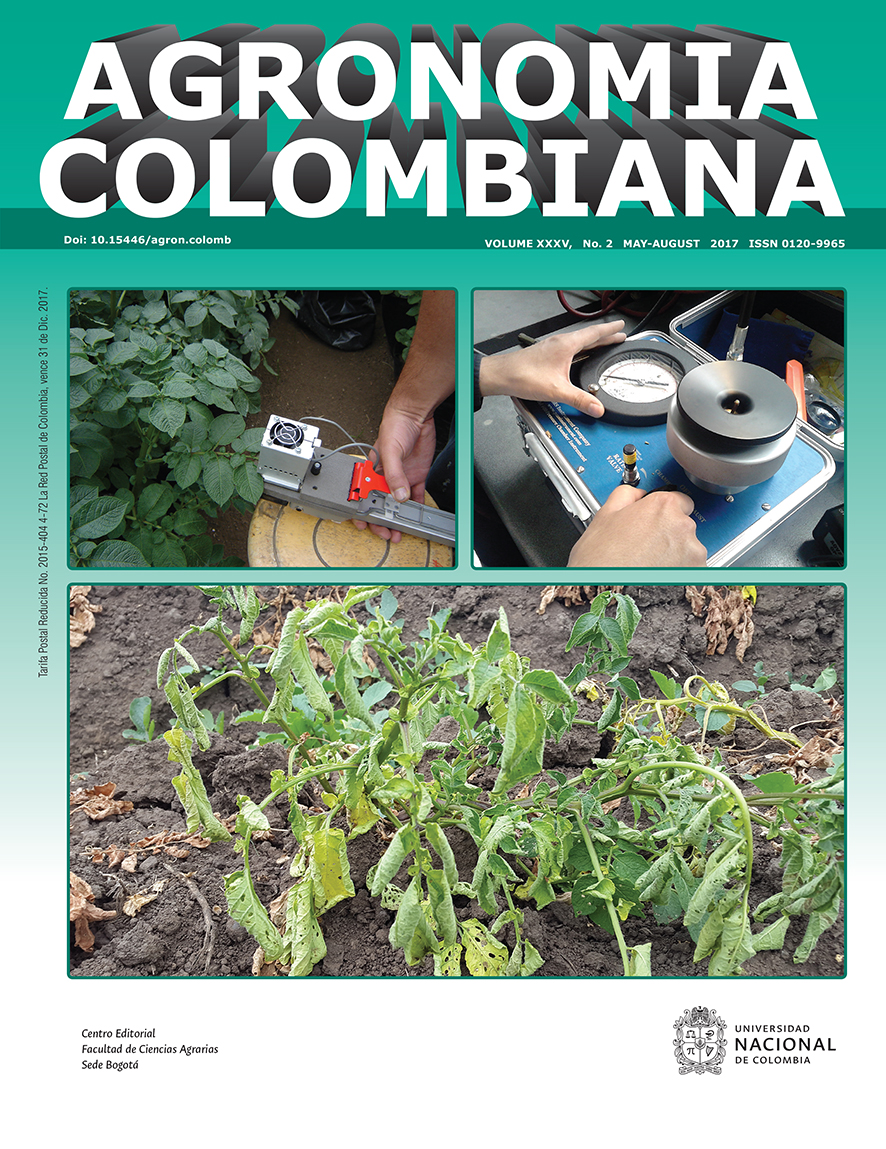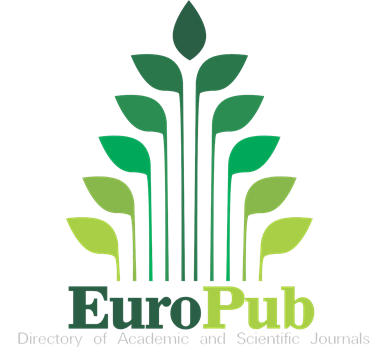Response of radish seedlings ( Raphanus sativus L.) to different concentrations of ammoniacal nitrogen in absence and presence of silicon
Respuesta de las plántulas del rábano ( Raphanus sativus L.) a diferentes concentraciones de nitrógeno amoniacal en ausencia y presencia de silicio
DOI:
https://doi.org/10.15446/agron.colomb.v35n2.62772Keywords:
beneficial element, abiotic stress, nitrogen, nutrient solution, vegetable (en)elemento benéfico, estrés abiótico, solución nutritiva, hortaliza (es)
Downloads
There are unknown thresholds about the effects of ammonia toxicity in the cultivation of radish and its prejudice is higher in the root than in the aerial part, been the use of silicon an alternative to mitigate this toxicity. The objective was to evaluate the response of radish crop to different concentrations of an ammonium nutrient solution in the absence and presence of silicon under greenhouse conditions. After 30 days of germination were evaluated photosynthesis, green color index, stomatal conductance, transpiration, leaf area, tap root diameter, dry matter accumulation of nitrogen and silicon in shoot parts and roots respectively. Ammonia toxicity in radish decreased photosynthesis, transpiration, and stomatal conductance, having greater prejudice in the dry matter accumulation of root and aerial part, this effect was mitigated with the presence of silicon in the nutrient solution.
References
Bataglia, O.C., A.M.C. Furlani, J.P.F. Teixeira, P.R. Furlani, and J.R. Gallo. 1983. Métodos de análise química de plantas. IAC-Boletim Téc. 78. Instituto Agronômico, Campinas, Brazil.
Barreto, R.F., R.M. Prado, A.J.F. Leal, M.J.B. Troleis, G.S. Junior, C.C. Monteiro, and R.F. Carvalho. 2016. Mitigation of ammonium toxicity by silicon in tomato depends on the ammonium concentration. Acta Agric. Scand. Sect. B Soil Plant Sci. 66(6), 483-488. Doi: 10.1080/09064710.2016.1178324.
Bianco, M.S., A.B. Cecilio Filho, and L.B. de Carvalho. 2015. Nutritional status of the cauliflower cultivar 'Verona' grown with omission of out added macronutrients. PloS One 10(4), 1-17. Doi: 10.1371/journal.pone.0123500.
Bittsánszky, A., K. Pilinszky, G. Gyulai, and T. Komives. 2015. Overcoming ammonium toxicity. Plant Sci. 231, 184-190. Doi: 10.1016/j.plantsci.2014.12.005
Bybordi, A. 2010. Influence of NO3:NH4 ratios and silicon on growth, nitrate reductase activity and fatty acid composition of canola under saline conditions. AJAR, 5(15),1984-1992. Doi: 10.5897/AJAR09.064.
Britto, D.T. and H.J. Kronzucker. 2002. NH4 + toxicity in higher plants: a critical review. J. Plant Physiol. 159(6), 567-584. Doi: 10.1078/0176-1617-0774.
Camargo, G.A., L. Consoli, I.C.S. Lellis, J. Mieli, and É.K. Sassaki. 2007. Bebidas naturais de frutas: Perspectivas de mercado, componentes funcionais e nutricionais/natural fruits beverages: Market outlook, functional and nutritional components. Rev. Bioeng. 1(2), 179-205. Doi: 10.18011/bioeng2007v1n2p179-205.
Chen, W., X. Yao, K. Cai, and J. Chen. 2011. Silicon alleviates drought stress of rice plants by improving plant water status, photosynthesis and mineral nutrient absorption. Biol. Trace Elem. Res. 142(1), 67-76. Doi: 10.1007/s12011-010-8742-x.
Feng, J., Q. Shi, X. Wang, M. Wei, F. Yang, and H. Xu. 2010. Silicon supplementation ameliorated the inhibition of photosynthesis and nitrate metabolism by cadmium (Cd) toxicity in Cucumis sativus L. Sci. Hortic. 123 (4), 521-530. Doi: 10.1016/j.scienta.2009.10.013.
Ferreira, D.F. 2011. Sisvar: a computer statistical analysis system. Ciênc. Agrotec. 35(6), 1039-1042. Doi: 10.1590/S1413-70542011000600001.
Filgueira, F.A.R. 2008. Novo manual de olericultura. Agrotecnologia moderna na producao e comercializacao de hortalicas. 3rd ed. Vicosa-MG UFV, São Paulo, Brazil.
Gao Q, Wang and X. Lu. 2014. Effects of exogenous silicon on physiological characteristics of cucumber seedlings under ammonium stress. J Appl Ecol. 25, 1395-1400.
Hachiya, T., C.K. Watanabe, M. Fujimoto, T. Ishikawa, K. Takahara, M. Kawai-Yamada, and K. Noguchi. 2012. Nitrate addition alleviates ammonium toxicity without lessening ammonium accumulation, organic acid depletion and inorganic cation depletion in Arabidopsis thaliana shoots. Plant Cell Physiol. 53(3), 577-591. Doi: 10.1093/pcp/pcs012.
Hoagland, D.R. and D.I. Arnon. 1950. The water-culture method for growing plants without soil. 2nd ed. California Agricultural Experiment Station, Berkeley, USA.
Huang, L., Y. Lu, X. Gao, G. Du, X. Ma, M. Liu, and Y. Chen. 2013. Ammonium-induced oxidative stress on plant growth and antioxidative response of duckweed (Lemna minor L.). Ecol. Eng. 58, 355-362. Doi: 10.1016/j.ecoleng.2013.06.031.
Kochanova, Z., K. Jaskova, B. Sedlakova, and M. Luxova. 2014. Silicon improves salinity tolerance and affects ammonia assimilation in maize roots. Biol. 69, 1164-1171. Doi: 10.2478/s11756-014-0411-7.
Kraska, J.E. and G.A. Breitenbeck. 2010. Simple, robust method for quantifying silicon in plant tissue. Comm. Soil Sci. Plant Anal. 41(17), 2075-2085. Doi: 10.1080/00103624.2010.498537.
Liang, Y., W. Sun, Y.G. Zhu, and P. Christie. 2007. Mechanisms of silicon-mediated alleviation of abiotic stresses in higher plants: a review. Environ. Pollut. 147(2), 422-428. Doi: 10.1016/j.envpol.2006.06.008.
Mateos-Naranjo, E., L. Andrades-Moreno, and A.J. Davy. 2013. Silicon alleviates deleterious effects of high salinity on the halophytic grass Spartina densiflora. Plant Physiol. Biochem. 63, 115-121. Doi: 10.1016/j.plaphy.2012.11.015.
Roosta, H.R. A., Sajjadinia, A. Rahimi, and J.K. Schjoerring. 2009. Responses of cucumber plant to NH4 + and NO3 - nutrition: the relative addition rate technique vs. cultivation at constant nitrogen concentration. Sci. Hortic. 121(4), 397-403. Doi: 10.1016/j.scienta.2009.03.004.
Song, A., P. Li, F. Fan, Z. Li, and Y. Liang. 2014. The Effect of Silicon on Photosynthesis and Expression of Its Relevant Genes in Rice (Oryza sativa L.) under High-Zinc Stress. PLoS One 9(11). Doi: 10.1371/journal.pone.0113782.
Sarasketa, A., M.B. Gonzalez-Moro, C. Gonzalez-Murua, and D. Marino. 2014. Exploring ammonium tolerance in a large panel of Arabidopsis thaliana natural accessions. J. Exp. Bot. Doi: 10.1093/jxb/eru342.
Setien, I., I. Vega-Mas, N. Celestino, M.E. Calleja-Cervantes, C. Gonzalez-Murua, J.M. Estavillo, and M.B. Gonzalez-Moro. 2014. Root phosphoenolpyruvate carboxylase and NAD-malic enzymes activity increase the ammonium-assimilating capacity in tomato. J. Plant Physiol. 171(5), 49-63. Doi: 10.1016/j.jplph.2013.10.021.
Vaculikova, M., M. Vaculik, L. Simkova, I. Fialova, Z. Kochanova, B. Sedlakova, and M. Luxova. 2014. Influence of silicon on maize roots exposed to antimony - Growth and antioxidative response. Plant Physiol. Biochem. 83, 279-284. Doi: 10.1016/j.plaphy.2014.08.014
Zanin, L., A. Zamboni, R. Monte, N. Tomasi, Z. Varanini, S. Cesco, and R. Pinton. 2015. Transcriptomic analysis highlights reciprocal interactions of urea and nitrate for nitrogen acquisition by maize roots. Plant Cell Physiol. 56(3), 532-548. Doi: 10.1093/pcp/pcu202.
Zebarth, B.J., H. Tai, S. Luo, P. Millard, D. De Koeyer, X.Q. Li, and X. Xiong. 2012. Effect of nitrogen form on gene expression in leaf tissue of greenhouse grown potatoes during three stages of growth. Am. J. Potato Res. 89(4), 315-327. Doi: 10.1007/s12230-015-9485-1.
How to Cite
APA
ACM
ACS
ABNT
Chicago
Harvard
IEEE
MLA
Turabian
Vancouver
Download Citation
CrossRef Cited-by
1. Edson Santos da Silva, Renato de Mello Prado, Anelisa de Aquino Vidal Lacerda Soares, Hilario Junior de Almeida, Durvalina Maria M. dos Santos. (2021). Response of Corn Seedlings (Zea mays L.) to Different Concentrations of Nitrogen in Absence and Presence of Silicon. Silicon, 13(3), p.813. https://doi.org/10.1007/s12633-020-00480-8.
2. Sinazo Ajibade, Hupenyu Allan Mupambwa, Alen Manyevere, Pearson Nyari Stephano Mnkeni. (2020). Influence of Microbial Inoculation of Igneous Rock Phosphate-Amended Cow and Pig Manures on Vermidegradation and Nutrient Release. Agronomy, 10(10), p.1587. https://doi.org/10.3390/agronomy10101587.
3. Muhammad Farhan, Manda Sathish, Rafia Kiran, Aroosa Mushtaq, Alaa Baazeem, Ammarah Hasnain, Fahad Hakim, Syed Atif Hasan Naqvi, Mustansar Mubeen, Yasir Iftikhar, Aqleem Abbas, Muhammad Zeeshan Hassan, Mahmoud Moustafa. (2024). Plant Nitrogen Metabolism: Balancing Resilience to Nutritional Stress and Abiotic Challenges. Phyton, 93(3), p.581. https://doi.org/10.32604/phyton.2024.046857.
4. Dilier Olivera Viciedo, Renato de Mello Prado, Rodolfo Lizcano Toledo, Dayami Salas Aguilar, Luiz Claudio Nascimento dos Santos, Alexander Calero Hurtado, Kolima Peña Calzada, Carmen Betancourt Aguilar. (2020). Physiological role of silicon in radish seedlings under ammonium toxicity. Journal of the Science of Food and Agriculture, 100(15), p.5637. https://doi.org/10.1002/jsfa.10587.
5. Fernando F. Putti, Camila P. Cremasco, Josué F. Silva Junior, Luís R. A. Gabriel Filho. (2022). FUZZY MODELING OF SALINITY EFFECTS ON RADISH YIELD UNDER REUSE WATER IRRIGATION. Engenharia Agrícola, 42(1) https://doi.org/10.1590/1809-4430-eng.agric.v42n1e215144/2022.
6. Renan J. Parecido, Rogério P. Soratto, Marcos J. Perdoná, Harun I. Gitari. (2022). Foliar-applied silicon may enhance fruit ripening and increase yield and nitrogen use efficiency of Arabica coffee. European Journal of Agronomy, 140, p.126602. https://doi.org/10.1016/j.eja.2022.126602.
7. Bruna Santos Silva, Renato De Mello Prado, Alexander Calero Hurtado, Renata Aparecida de Andrade, Gilmara Pereira da Silva. (2020). AMMONIA TOXICITY AFFECT CATIONS UPTAKE AND GROWTH IN PAPAYA PLANTS INCLUSIVE WITH SILICON ADDITION. Acta Biológica Colombiana, 25(3), p.345. https://doi.org/10.15446/abc.v25n3.79490.
8. Dilier Olivera-Viciedo, Kamilla Silva Oliveira, Cíntia Cármen de Faria Melo, Danilo Silva Amaral, Renato de Mello Prado. (2024). Silicon Advances for Sustainable Agriculture and Human Health. Sustainable Plant Nutrition in a Changing World. , p.287. https://doi.org/10.1007/978-3-031-69876-7_14.
9. Renan J. Parecido, Rogério P. Soratto, Fernando V. C. Guidorizzi, Marcos J. Perdoná, Harun I. Gitari. (2022). Soil application of silicon enhances initial growth and nitrogen use efficiency of Arabica coffee plants. Journal of Plant Nutrition, 45(7), p.1061. https://doi.org/10.1080/01904167.2021.2006707.
10. Dilier Olivera Viciedo, Renato de Mello Prado, Rodolfo Lizcano Toledo, Luiz Claudio Nascimento dos Santos, Alexander Calero Hurtado, Luke Leroy Theodore Nedd, Leonides Castellanos Gonzalez. (2019). Silicon Supplementation Alleviates Ammonium Toxicity in Sugar Beet (Beta vulgaris L.). Journal of Soil Science and Plant Nutrition, 19(2), p.413. https://doi.org/10.1007/s42729-019-00043-w.
11. Keqi Zhao, Yuan Yang, Hua Peng, Lihua Zhang, Yaoyu Zhou, Jiachao Zhang, Chunyan Du, Junwu Liu, Xu Lin, Nanyi Wang, Hongli Huang, Lin Luo. (2022). Silicon fertilizers, humic acid and their impact on physicochemical properties, availability and distribution of heavy metals in soil and soil aggregates. Science of The Total Environment, 822, p.153483. https://doi.org/10.1016/j.scitotenv.2022.153483.
12. Iago Martins Moreira, Antonio Carlos Pereira de Menezes Filho, Leandro Carlos, Matheus Vinicius Abadia Ventura. (2022). Avaliação de tubérculos de rabanete (Raphanus sativus) Brassicaceae submetidos a diferentes doses de Si (Plus, GigaMix®). Brazilian Journal of Science, 1(10), p.22. https://doi.org/10.14295/bjs.v1i10.174.
13. Jackson De Mesquita Alves, Alex Serafim De Lima, Francisco Romário Andrade Figueiredo, Toshik Iarley Da Silva, Lourival Ferreira Cavalcante, Francisco De Oliveira Mesquita, Evandro Franklin De Mesquita, Cesenildo De Figueiredo Suassuna. (2020). Chlorophyll a fluorescence and development of zucchini plants under nitrogen and silicon fertilization. Agronomía Colombiana, 38(1), p.45. https://doi.org/10.15446/agron.colomb.v38n1.79172.
14. Othman Khalid Alwan, Ghassan Jaafar Hamdi, Rafid Abdullah Maleh. (2023). Methyl jasmonate and type of fertilization affect growth, production and accumulation of sulforaphane in black radish taproot. International Journal of Vegetable Science, 29(2), p.178. https://doi.org/10.1080/19315260.2023.2170302.
Dimensions
PlumX
Article abstract page views
Downloads
License
Copyright (c) 2017 Agronomía Colombiana

This work is licensed under a Creative Commons Attribution-NonCommercial-ShareAlike 4.0 International License.
© Centro Editorial de la Facultad de Ciencias Agrarias, Universidad Nacional de Colombia
Reproduction and quotation of material appearing in the journal is authorized provided the following are explicitly indicated: journal name, author(s) name, year, volume, issue and pages of the source. The ideas and observations recorded by the authors are their own and do not necessarily represent the views and policies of the Universidad Nacional de Colombia. Mention of products or commercial firms in the journal does not constitute a recommendation or endorsement on the part of the Universidad Nacional de Colombia; furthermore, the use of such products should comply with the product label recommendations.
The Creative Commons license used by Agronomia Colombiana journal is: Attribution - NonCommercial - ShareAlike (by-nc-sa)

Agronomia Colombiana by Centro Editorial of Facultad de Ciencias Agrarias, Universidad Nacional de Colombia is licensed under a Creative Commons Reconocimiento-NoComercial-CompartirIgual 4.0 Internacional License.
Creado a partir de la obra en http://revistas.unal.edu.co/index.php/agrocol/.





















